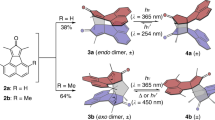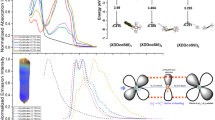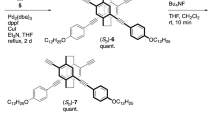Abstract
The polymerization of enantiopure pseudo-meta-diethynyl[2.2]paracyclophane with a diiodobenzene derivative was carried out through Sonogashira-Hagihara cross-coupling. The synthesized polymers consisted of three-ring para-phenylene-ethynylene π-electron systems that were stacked on each other at the terminal benzenes. The electrical photoconductivities of the pseudo-meta-linked and pseudo-para-linked polymers were examined. The corresponding optically active pseudo-meta-linked dimers were prepared, and their optical and chiroptical properties were compared with those of the pseudo-para- and pseudo-ortho-linked dimers. Optically active pseudo-meta-linked dimers and polymers emitted intense circularly polarized luminescence (CPL) with relatively high anisotropy factors on the order of 10–3. The CPL behavior of the optically active pseudo-meta-linked dimer was simulated using time-dependent density functional theory calculations.
This is a preview of subscription content, access via your institution
Access options
Subscribe to this journal
Receive 12 print issues and online access
$259.00 per year
only $21.58 per issue
Buy this article
- Purchase on Springer Link
- Instant access to full article PDF
Prices may be subject to local taxes which are calculated during checkout










Similar content being viewed by others
References
Vögtle, F. Cyclophane Chemistry: Synthesis, Structures and Reactions. John Wiley & Sons: Chichester; 1993.
Gleiter, R, Hopf H. Modern Cyclophane Chemistry. Wiley-VCH: Weinheim; 2004.
Hopf H. [2.2]Paracyclophanes in Polymer Chemistry and Materials Science. Angew Chem Int Ed. 2008;47:9808–12.
Brown CJ, Farthing AC. Preparation and structure of Di-p-Xylylene. Nature. 1949;164:915–6.
Cram DJ, Steinberg H. Macro Rings. I. Preparation and spectra of the paracyclophanes. J Am Chem Soc. 1951;73:5691–704.
Wang S, Bazan GC, Tretiak S, Mukamel S. Oligophenylenevinylene Phane Dimers: probing the effect of contact site on the optical properties of bichromophoric pairs. J Am Chem Soc. 2000;122:1289–97.
Bartholomew GP, Bazan GC. Bichromophoric paracyclophanes: models for interchromophore delocalization. Acc Chem Res. 2001;34:30–9.
Bartholomew GP, Bazan GC. Strategies for the Synthesis of ‘Through-space’ Chromophore Dimers Based on [2.2]Paracyclophane. Synthesis. 2002;1245–55.
Hong JW, Woo HY, Bazan GC. Solvatochromism of distyrylbenzene pairs bound together by [2.2]Paracyclophane: evidence for a polarizable “Through-space” delocalized state. J Am Chem Soc. 2005;127:7435–43.
Bazan GC. Novel organic materials through control of multichromophore interactions. J Org Chem. 2007;72:8615–35.
Cram DJ, Allinger NL. Macro Rings. XII stereochemical consequences of steric compression in the smallest paracyclophane. J Am Chem Soc. 1955;77:6289–94.
Rozenberg V, Sergeeva E, Hopf H. Cyclophanes as templates in stereoselective synthesis. In Gleiter R, Hopf H, editors. Modern Cyclophane Chemistry. Wiley-VCH: Weinheim; 2004, p. 435–62.
Rowlands GJ. The synthesis of enantiomerically pure [2.2]paracyclophane derivatives. Org Biomol Chem. 2008;6:1527–34.
Gibson SE, Knight JD. [2.2]Paracyclophane derivatives in asymmetric catalysis. Org Biomol Chem. 2003;1:1256–69.
Aly AA, Brown AB. Asymmetric and fused heterocycles based on [2.2]Paracyclophane. Tetrahedron. 2009;65:8055–89.
Paradies J. [2.2]Paracyclophane derivatives: synthesis and application in catalysis. Synthesis. 2011;3749–66.
Delcourt M-L, Felder S, Turcaud S, Pollok CH, Merten C, Micouin L, et al. Highly enantioselective asymmetric transfer hydrogenation: a practical and scalable method to efficiently access planar chiral [2.2]paracyclophanes. J Org Chem. 2019;84:5369–82.
Vorontsova NV, Rozenberg VI, Sergeeva EV, Vorontsov EV, Starikova ZA, Lyssenko KA, et al. Symmetrically tetrasubstituted [2.2]Paracyclophanes: their systematization and regioselective synthesis of several types of bis-bifunctional derivatives by double electrophilic substitution. Chem Eur J. 2008;14:4600–17.
David ORP. Syntheses and applications of disubstituted [2.2]Paracyclophanes. Tetrahedron. 2012;68:8977–93.
Hassan Z, Spluling E, Knoll DM, Lahann J, Bräse S. Planar Chiral [2.2]Paracyclophanes: from synthetic curiosity to applications in asymmetric synthesis and materials. Chem Soc Rev. 2018;47:6947–63.
Hassan Z, Spuling E, Knoll DM, Bräse S. Regioselective functionalization of [2.2]Paracyclophanes: recent synthetic progress and perspectives. Angew Chem Int Ed. 2020;59:2156–70.
Felder S, Wu S, Brom J, Micouin L, Benedetti E. Enantiopure Planar Chiral [2.2]Paracyclophanes: synthesis and applications in asymmetric organocatalysis. Chirality. 2021;33:506–27.
Morisaki Y. Circularly Polarized Luminescence from Planar Chiral Compounds Based on [2.2]Paracyclophane. In: Mori T, editor. Circularly Polarized Luminescence of Isolated Small Organic Molecules. Springer: Singapore; 2020, p. 31–52.
Morisaki, Y. Circularly Polarized Luminescence (CPL) Based on Planar Chiral [2.2]Paracyclophane. In: Ooyama Y, Yagi S, editors. Progress in the Science of Functional Dyes. Springer: Singapore; 2021, p. 343–74.
Morisaki Y, Chujo Y. Planar Chiral [2.2]Paracyclophanes: optical resolution and transformation to optically active π-stacked molecules. Bull Chem Soc Jpn. 2019;92:265–74.
Maeda H, Kameda M, Hatakeyama T, Morisaki Y. π-Stacked polymer consisting of a Pseudo-meta-[2.2]Paracyclophane skeleton. Polymers. 2018;10:1140. https://doi.org/10.3390/polym10101140.
Gon M, Sawada R, Morisaki Y, Chujo Y. Enhancement and controlling the signal of circularly polarized luminescence based on a Planar Chiral Tetrasubstituted [2.2]Paracyclophane Framework in Aggregation System. Macromolecules. 2017;50:1790–802.
Gon M, Morisaki Y, Sawada R, Chujo Y. Synthesis of optically active X-shaped conjugated compounds and dendrimers based on Planar Chiral [2.2]Paracyclophane, leading to highly emissive circularly Polarized Luminescence. Chem Eur J. 2016;22:2291–8.
Morisaki Y, Inoshita K, Shibata S, Chujo Y. Synthesis of optically active through-space conjugated polymers consisting of Planar Chiral [2.2]Paracyclophane and Quaterthiophene. Polym J. 2015;47:278–81.
Morisaki Y, Hifumi R, Lin L, Inoshita K, Chujo Y. Through-space conjugated polymers consisting of Planar Chiral Pseudo-ortho-linked [2.2]Paracyclophane. Polym Chem. 2012;3:2727–30.
Liao C, Zhang Y, Ye S-H, Zheng W-H. Planar Chiral [2.2]Paracyclophane-based thermally activated delayed fluorescent materials for circularly polarized electroluminescence. ACS Appl Mater Int. 2021;13:25186–92.
Zhang M-Y, Li Z-Y, Lu B, Wang Y, Ma Y-D, Zhao C-H. Solid-state emissive triarylborane-based [2.2]Paracyclophanes displaying circularly polarized luminescence and thermally activated delayed fluorescence. Org Lett. 2018;20:6868–71.
Morisaki Y, Hifumi R, Lin L, Inoshita K, Chujo Y. Practical optical resolution of Planar Chiral Pseudo-ortho-disubstituted [2.2]Paracyclophane. Chem Lett. 2012;41:990–2.
Tsuchiya M, Maeda H, Inoue R, Morisaki Y. Construction of Helical Structures with Planar Chiral [2.2]Paracyclophane: fusing helical and planar chiralities. Chem Commun. 2021;57:9256–9.
Kikuchi K, Nakamura J, Nagata Y, Tsuchida H, Kakuta T, Ogoshi T, et al. Control of circularly polarized luminescence by orientation of stacked π-Electron Systems. Chem Asian J. 2019;14:1681–5.
Morisaki Y, Sawada R, Gon M, Chujo Y. New Type of Planar Chiral [2.2]Paracyclophanes and construction of one-handed double Helices. Chem Asian J. 2016;11:2524–7.
Sawada R, Gon M, Nakamura J, Morisaki Y, Chujo Y. Synthesis of Enantiopure Planar Chiral Bis-(para)-Pseudo-meta-Type [2.2]Paracyclophanes. Chirality. 2018;30:1109–14.
Morisaki Y, Gon M, Sasamori T, Tokitoh N, Chujo Y. Planar Chiral Tetrasubstituted [2.2]Paracyclophane: optical resolution and functionalization. J Am Chem Soc. 2014;136:3350–3.
Sonogashira K, Tohda Y, Hagihara N. A convenient synthesis of acetylenes: catalytic substitutions of acetylenic hydrogen with bromoalkenes, iodoarenes and bromopyridines. Tetrahedron Lett. 1975;16:4467–70.
Sonogashira K. Palladium-Catalyzed Alkynylation: Sonogashira Alkyne Synthesis. In: Negishi E, editor. Handbook of Organopalladium Chemistry for Organic Synthesis. Wiley-Interscience: New York; 2002, p. 493–529.
Meyer-Epler G, Sure R, Schneider A, Schnakenburg G, Grimme S, Lützen A. Synthesis, Chiral Resolution, and absolute configuration of dissymmetric 4,15-Difunctionalized [2.2]Paracyclophanes. J Org Chem. 2014;79:6679–87.
Miki N, Maeda H, Inoue R, Morisaki Y. Syntheses and Chiroptical properties of optically active V-shaped molecules based on Planar Chiral [2.2]Paracyclophane. ChemistrySelect. 2021;6:12970–4.
Bondarenko L, Dix I, Hinrichs H, Hopf H. Cyclophanes. Part LII: Ethynyl[2.2]paracyclophanes - New Building Blocks for Molecular Scaffolding. Synthesis. 2004;2751–9.
Tanaka Y, Ozawa T, Inagaki A, Akita M. Redox-active Polyiron Complexes with Tetra(ethynylphenyl)ethene and [2,2]Paracyclophane spacers containing ethynylphenyl units: extension to higher dimensional molecular wire. Dalton Trans. 2007;928–33.
Morisaki Y, Ueno S, Saeki A, Asano A, Seki S, Chujo Y. π-Electron-system-layered Polymer: through-space conjugation and properties as a single molecular wire. Chem Eur J. 2012;18:4216–24.
Morisaki Y, Inoshita K, Chujo Y. Planar Chiral through-space conjugated oligomers: synthesis and characterization of Chiroptical Properties. Chem Eur J. 2014;20:8386–90.
Saeki A. Evaluation-oriented exploration of photo energy conversion systems: from fundamental optoelectronics and material screening to the combination with Data Science. Polym J. 2020;52:1307–21.
Miki N, Inoue R, Morisaki Y. Synthesis of optically active V-shaped molecules: studies on the orientation of the Stacked π-Electron Systems and Their Chiroptical Properties. Bull Chem Soc Jpn. 2021;94:451–3.
Tabata D, Inoue R, Sasai Y, Morisaki Y. Synthesis of optically active V(120°)- and (60°)-shaped molecules comprising different π-electron systems. Bull Chem Soc Jpn. 2022;95:595–601.
Asakawa R, Tabata D, Miki N, Tsuchiya M, Inoue R, Morisaki Y. Syntheses of optically active V-shaped molecules: relationship between their Chiroptical Properties and the Orientation of the Stacked π-Electron System. Eur J Org Chem. 2021;2021:5725–31.
Berova N, Nakanishi K, Woody RW. Circular Dichroism 2nd ed. Wiley-VCH: Toronto; 2000.
Riehl JP, Richardson FS. Circularly polarized luminescence spectroscopy. Chem Rev. 1986;86:1–16.
Riehl JP, Muller F. Comprehensive Chiroptical Spectroscopy. Wiley and Sons: New York; 2012.
Acknowledgements
The authors are grateful to Professor Kazuo Tanaka and Dr. Masayuki Gon (Graduate School of Engineering, Kyoto University) for CD and CPL spectroscopy. The financial support by Grant-in-Aid for Scientific Research (B) (No. 19H02792) from the Japan Society for the Promotion of Science is acknowledged (YM). This work was also partly supported by the Nippon Sheet Glass Foundation for Materials Science and Engineering (YM).
Author information
Authors and Affiliations
Corresponding author
Ethics declarations
Conflict of interest
The authors declare no competing interests.
Additional information
Publisher’s note Springer Nature remains neutral with regard to jurisdictional claims in published maps and institutional affiliations.
Supplementary information
Rights and permissions
Springer Nature or its licensor holds exclusive rights to this article under a publishing agreement with the author(s) or other rightsholder(s); author self-archiving of the accepted manuscript version of this article is solely governed by the terms of such publishing agreement and applicable law.
About this article
Cite this article
Maeda, H., Inoue, R., Saeki, A. et al. Synthesis of optically active through-space conjugated polymers consisting of planar chiral pseudo-meta-disubstituted [2.2]paracyclophane. Polym J 55, 537–545 (2023). https://doi.org/10.1038/s41428-022-00703-2
Received:
Revised:
Accepted:
Published:
Issue Date:
DOI: https://doi.org/10.1038/s41428-022-00703-2



